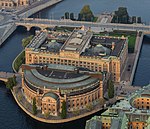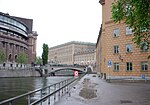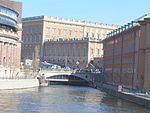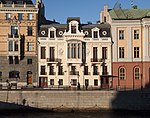Riksdag

The Riksdag (Swedish: [ˈrɪ̌ksdɑː(ɡ)] (listen), lit. transl. "diet of the realm"; also Swedish: riksdagen [ˈrɪ̌ksdan] (listen) or Sveriges riksdag [ˈsvæ̌rjɛs ˈrɪ̌ksdɑː(ɡ)] (listen)) is the national legislature and the supreme decision-making body of Sweden. Since 1971, the Riksdag has been a unicameral legislature with 349 members (riksdagsledamöter), elected proportionally and serving, from 1994 onwards, on fixed four-year terms. As of 2021, the 2018 Swedish general election is the most recent held general election. The constitutional functions of the Riksdag are enumerated in the Instrument of Government (Regeringsformen), and its internal workings are specified in greater detail in the Riksdag Act (Riksdagsordningen). The seat of the Riksdag is at Parliament House (Swedish: Riksdagshuset [ˈrɪ̂ksdɑː(ɡ)sˌhʉːsɛt] (listen)), on the island of Helgeandsholmen in the central parts of Stockholm. The Riksdag has its institutional roots in the feudal Riksdag of the Estates, by tradition thought to have first assembled in Arboga in 1435, and in 1866 following reforms of the 1809 Instrument of Government that body was transformed into a bicameral legislature with an upper chamber (Första Kammaren) and a lower chamber (Andra Kammaren).
Excerpt from the Wikipedia article Riksdag (License: CC BY-SA 3.0, Authors, Images).Riksdag
Riksgatan, Stockholm Gamla stan (Södermalms stadsdelsområde)
Geographical coordinates (GPS) Address Nearby Places Show on map
Geographical coordinates (GPS)
| Latitude | Longitude |
|---|---|
| N 59.3275 ° | E 18.0675 ° |
Address
Riksdagshuset
Riksgatan
103 21 Stockholm, Gamla stan (Södermalms stadsdelsområde)
Sweden
Open on Google Maps











